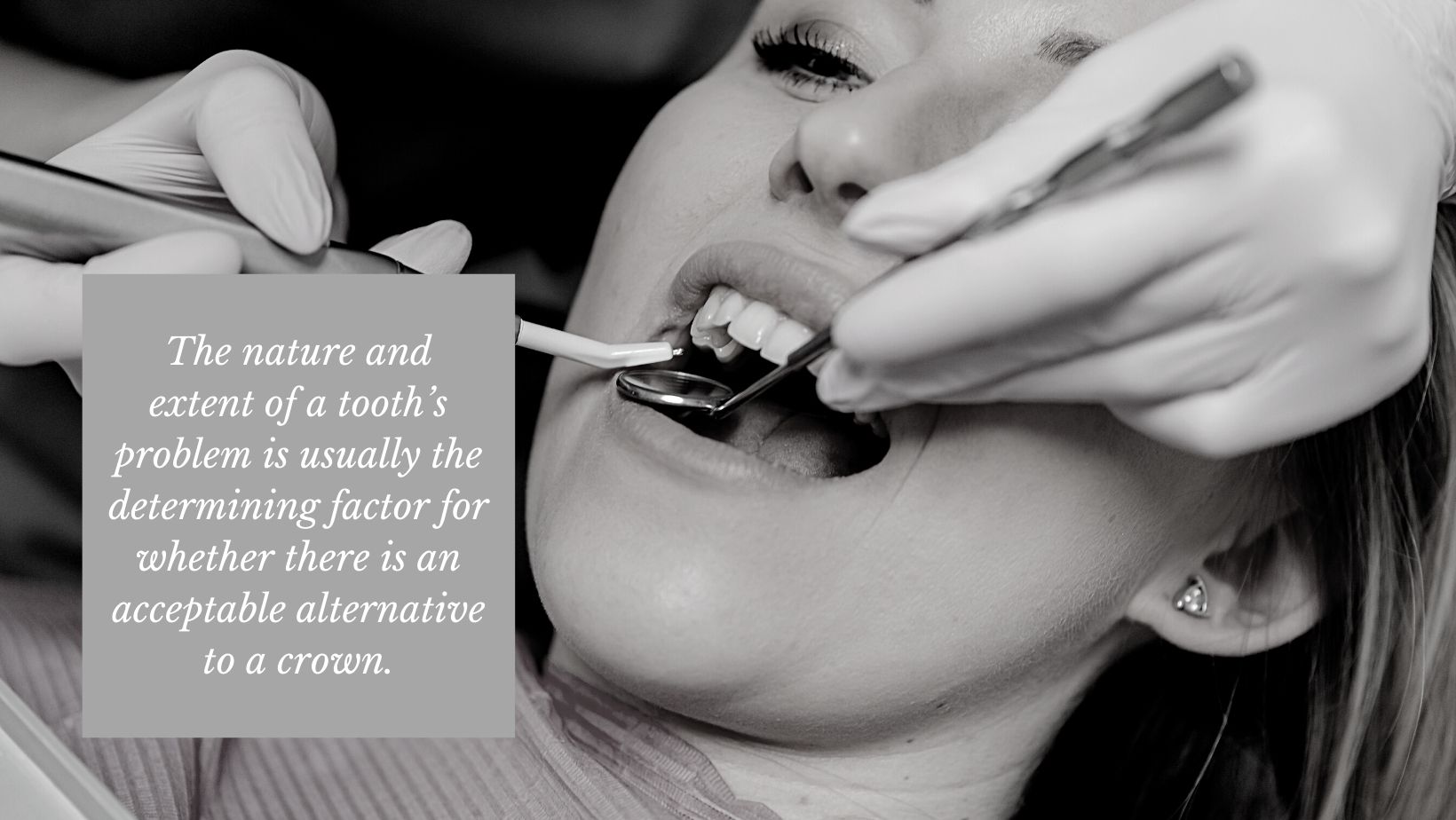When the dentist recommends a dental crown, patients might wonder if they have a choice. There are other options, but sometimes a crown is the most effective and economical alternative.
Fixing the damaged tooth is the dentist’s top priority, but it is understandable that cost, convenience, and appearance are also important factors for the patient. Understanding what crowns in dentistry do, as well as the available alternatives to crowns, will help in making the decision.
What is a Dental Crown?
A dental crown is a cap that covers a tooth. It is shaped to look and feel as close to the original tooth as possible. Gold crowns are the most expensive and conspicuous. Other materials, such as porcelain and composite resin, are more affordable and are tinted to match the patient’s natural tooth color.
What is a Dental Crown’s Purpose?
There are a number of different uses for crowns in dentistry:
Root canal. The most common is after a root canal procedure. Repairing a damaged root canal involves drilling a hole into the tooth. Once the hole is filled, a dental crown caps the tooth, sealing it off from further bacteria and decay.
Decay. A tooth with several cavities (or one very large one) may need a crown, even if a root canal procedure is not necessary. Multiple fillings weaken the tooth’s structure. A crown will give it a solid foundation and biting surface that will withstand the wear and tear of chewing.
Cosmetic imperfections. Dental crowns can cover up chipped, cracked, or stained teeth.
Bridge support. When a patient needs one or more false teeth—called a bridge—crowns placed on the neighboring healthy teeth provide an anchor to attach the partial dentures.
Dental implants. A dental implant is a false tooth embedded directly into the jawbone with a titanium post. A dental crown is placed on top to complete the look and feel of a real tooth.
What It’s Like to Get a Dental Crown
After a root canal procedure (if the patient needs one) a mold or impression is made of the tooth using putty. This way, the crown can be made to the exact dimensions so it fits snuggly on the tooth. In the case of a dental implant, a knob-like piece of metal called an abutment sits atop the titanium post. An impression is still necessary so that the crown is the right height and width to align properly with the other teeth.
Impressions are sent to a lab where technicians craft a tooth out of the chosen material—gold, porcelain, porcelain fused to metal, or composite resin. This takes about two weeks. The dentist may fit the patient with a temporary crown so they are able to eat normally while they wait.
Some dental practices have software and equipment that eliminates the wait time for a crown. Using a handheld 3D scanner, they can take digital measurements of the tooth. Then, with an on-site milling machine, the crown can be carved from resin or porcelain. Measuring the tooth, creating the crown, and placing it in the patient’s mouth can all happen during one appointment.

Whether on the same day or a few weeks later, the procedure for placing a crown is the same. Dental cement secures the crown in place.
Patients typically feel some discomfort after getting a crown. This has less to do with the crown itself than with the procedures that preceded it. A root canal will be sore and sensitive for a few days. But if a crown is placed to cover up a chip, there might be very little discomfort.
Alternatives to Crowns
The nature and extent of a tooth’s problem is usually the determining factor for whether there is an acceptable alternative to a crown. Here are some options and when they might be appropriate:
Fillings. Depending on the size and location of tooth decay, a filling might be all that is necessary. The important thing is to make sure that the tooth is strong enough to accommodate chewing. If a dentist recommends a crown, it is usually because more than half of the tooth is decayed and it can not handle any more filling material.
Partial crowns or onlays. Instead of a cap that covers the entire tooth, a partial crown, also called an onlay, covers only part of it. Often it is only on one surface of the tooth, such as the chewing surface. This is a slightly less expensive alternative, but it requires a tooth that has not lost a lot of its structure.
Dental bonding. For cosmetic imperfections, a patient might choose bonding instead of dental crowns. Bonding involves using composite (the same material used in a filling) to cover up flaws on a tooth such as a chip or crack.

Veneers. Veneers are custom-made “false fronts” for teeth. They are typically used only on the visible surface of a tooth. Veneers successfully cover chips, cracks, and severe staining. They differ from bonding in that they require the removal of some of the tooth’s enamel before they can be placed on the teeth. And just like a crown, veneers are created in a lab, so there is a waiting period before attaching them.
Extraction. Having a tooth pulled is a last resort, and is not usually a good alternative to a crown. Missing teeth can cause additional problems. The teeth may shift, causing pain and making it difficult to chew. Dentures or implants are usually recommended to replace a missing tooth. Either of these can be more expensive than getting a crown—plus, a crown might be necessary as part of the process anyway!
Follow a Professional’s Advice for Crowns in Dentistry
Dentists do not recommend dental crowns without a good reason. That does not mean that a patient can not ask about alternatives. If there are concerns such as the cost or discomfort of getting a crown, discuss them with the dentist. A good dentist will take the time to explain the need for a crown—and all other possible options.
If you are looking for a dentist in your area, the Dental Health Society’s online search tool will help you find one and make an appointment.


